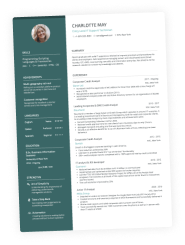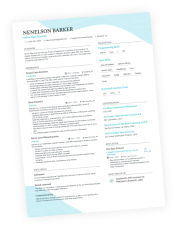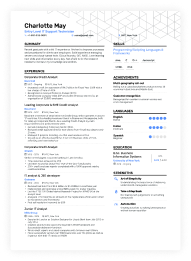Job shadowing helped thousands of Enhancv users get their foot in the door, especially when they had no “real” experience to show. It’s one of the most underrated things you can add to your resume, whether you’re starting out, switching careers, or returning after a break.
The problem is that most people either skip it or list it as an afterthought.
We’ve seen how a well-placed shadowing entry can build credibility, show initiative, and get recruiters to take a second look. With millions of resumes under our belt, we’ll show you exactly how to feature job shadowing the right way and why it could land you an interview.
Key takeaways
- Job shadowing is a valuable form of experience that can help you stand out on a resume, especially when you're new to the workforce or switching careers.
- Field observations can strengthen a no-experience resume by presenting shadowing in a dedicated section that mirrors the structure of standard work experience.
- You can list shadowing in multiple resume sections (work experience, highlights, or a customized job shadowing section), depending on relevance and your career stage.
- Use job-specific keywords, clear titles, and concrete numbers to turn even a short shadowing stint into something credible and professional.
- Enhancv makes it easy to format and highlight job shadowing with resume templates designed for students, career changers, and anyone building experience from the ground up.
Ready to see how your resume stacks up? Upload it to our Resume Checker and get instant, expert feedback.
Is your resume good enough?
Drop your resume here or choose a file. PDF & DOCX only. Max 2MB file size.
What is job shadowing?
Job shadowing is a short-term, observation-based learning experience where you follow a professional during their daily tasks to see how the job is actually done. It's hands-on in the sense that you're right there in the workflow, but you're mostly watching, asking questions, and absorbing how the role works in the real world.
Shadowing’s often used interchangeably with externships or field observations, especially in healthcare and education. Unlike internships or volunteer roles, it doesn’t usually involve completing tasks—the focus is learning, not working.
Job shadowing is more relevant than ever
According to research by McLean & Co. featured by WorldatWork, job shadowing is now being re-embraced as a key strategy for onboarding, upskilling, and talent retention across industries.
In a tight labor market where a lack of career development is a top reason people quit, shadowing gives workers access to real experience, mentorship, and career visibility, especially in remote and hybrid environments.
Who can benefit from shadowing experience in the US?
Job shadowing isn’t just for high schoolers. It’s used across industries and career stages.
Here’s who it’s especially useful for:
- Students and recent grads: Gain real-world exposure before landing your first job.
- Career changers: Test-drive a new industry without committing to full-time work.
- People returning to the workforce: Get up to speed after a break and rebuild confidence.
- Military-to-civilian transitions: Translate military experience into civilian roles with hands-on context.
- Internship applicants: Strengthen your resume if you haven’t secured a full internship yet.
- Anyone with limited experience: Show initiative and learning drive, especially in competitive fields.
- Job seekers exploring multiple paths: Compare roles to make more informed decisions.
- Remote workers looking to shift roles internally: Get visibility into other departments or roles.
- Anyone needing to showcase soft skills: Shadowing lets you highlight communication, teamwork, and problem-solving, even if you weren’t the one doing the work.
Most resumes are scanned by ATS software before a human ever reads them. These systems look for keywords that match the job description (e.g., "project coordination," "data entry," "client communication").
Why does it matter for job shadowing?
If you phrase your shadowing experience using the right keywords—the ones from job ads—it has a better chance of getting picked up by the ATS, even if it's not "real" work experience.
Author’s take
Knowing who benefits from shadowing is only half the story. The real impact comes when you actually put it on your resume. Done right, it can do more than just fill a gap.
Should you put shadowing on a resume at all?
Only if it helps your case. But when it does, it can be a real asset because it shows action, effort, and direction.
When shadowing is worth listing on a resume:
- When your shadowing experience is relevant to the job you’re targeting: If you observed a role similar to the one you're applying for, it shows alignment and industry exposure.
- When you don’t have much direct experience: Field observations prove you’ve taken steps to learn and understand the job, even if you haven’t officially held the title.
- When you shadowed someone senior or respected: Mentioning a director, manager, or industry-recognized expert adds weight and credibility.
- When you're applying for internships or entry-level roles: Shadowing gives you something concrete to talk about when you don’t have formal work history yet.
That said, there are times when shadowing is better left off, or moved to your cover letter. In some cases, it may even backfire: if it feels like fluff, hiring managers might press you on it in an interview, only to realize there’s not much substance behind it.
When to remove shadowing from your resume:
- It’s completely unrelated to the job you’re applying for: For instance, you shadowed a teacher but are applying for a sales role with no transferable relevance.
- You already have stronger, more relevant experience listed: Shadowing shouldn’t push down actual jobs or internships.
- The shadowing lasted just a few hours and didn’t involve meaningful learning: Mention it briefly in your cover letter or leave it out altogether.
- You can’t clearly explain what you observed or learned: If it’s vague or hard to articulate, it won’t add value.
- It’s taking up space that could be used for more impactful content: Skills, certifications, or volunteer work might carry more weight.
If any of those apply to you, then the next step is knowing how to actually list your shadowing experience so it works for you.
How to include job shadowing on your resume
Shadowing can fit into a resume just like any other work experience—but how you include it depends on your career stage and how much context you need to give.
There’s more than one way to do that.
Option #1: Add it under work experience (ideal placement)
This is the most effective and straightforward way to include job shadowing, especially if it’s directly related to the position you’re applying for. Treat it like any other job entry: structured, intentional, and clearly framed for relevance.
Here’s how to do it:
- Use a clear, professional title, like: “Job Shadowing – Marketing Coordinator” or “Shadow Experience – Software Engineering Team.”
- Include the company name, location, and the timeframe you shadowed (month + year is enough). Even if it was a short stint, giving it structure makes it more credible.
- List three to five bullet points describing what you observed, supported, or participated in. Focus on what’s relevant to the job you want, not just everything you saw.
- Use action-oriented language. Even if you were observing, phrases like “Engaged with”, “Participated in”, “Gained exposure to”, or “Observed [...] in practice” sound more active and thoughtful than just “watched” or “followed.”
- If possible, show impact or learning. A line like “Suggested process improvements during review meetings” or “Learned industry-standard tools such as Salesforce and HubSpot” tells the recruiter there was value in the experience.
PRO TIP
If your shadowing only lasted a few hours, skip the specifics on your resume. Focus on what you observed and learned, not how long you were there. You can always talk about the duration if it comes up in an interview.
Looking for a simple template you can follow when writing about shadowing on your resume? Look no further.
[Your Title – Shadowing or Job Shadowing]
Company Name | City, State
Month Year – Month Year
- [What you observed or assisted with—focus on tasks relevant to your target role]
- [What you learned, practiced, or contributed—bonus points for tools, skills, or outcomes]
Below is an example of how to list shadowing in the experience section, created with Enhancv’s Resume Builder:
- •Observed patient intake procedures, routine check-ups, and daily care coordination alongside the nursing team in a high-volume ER.
- •Gained exposure to electronic medical records (Epic Systems) and basic triage documentation protocols.
- •Attended team debriefings and shadowed interdisciplinary collaboration between nurses, physicians, and social workers.
Option #2: Аlternative sections
Nothing on a resume is set in stone. You can be flexible when listing shadowing, depending on how long ago it was and how relevant it is to your current career goals.
Let’s look at the options.
Put it in a dedicated shadowing experience section
Use this placement if you’ve completed multiple shadowing stints across different roles or industries, or if you want to clearly separate unpaid learning experiences from paid employment.
Here’s how to do it:
- Create a section titled Shadowing Experience or Relevant Experience (no, it doesn’t have to explicitly say “shadowing”).
- Use consistent formatting—job title, company, dates, location, and bullet points, just like you would in a traditional work history section.
- For each entry, focus on what you learned and how it connects to the kind of roles you're applying for now.
See how this looks on a resume for a future teacher:
- •Observed classroom management techniques and differentiated instruction in a 3rd-grade setting.
- •Assisted with preparing learning materials and supporting students during reading workshops.
- •Gained exposure to lesson planning, grading strategies, and classroom technology tools (Google Classroom, Turnitin).
- •Sat in on parent-teacher conferences and observed how student performance data informs instruction.
Mention it under your career highlights or achievements
This placement works especially well if you’re a mid-career or senior professional who shadowed someone in a leadership role—particularly if it's a position you're aiming to transition into. At this stage, you likely don’t want to clutter your experience section, but you do want to name-drop in a way that gets noticed. (You can use the same tactic in your cover letter, too.)
It’s also the perfect spot to briefly mention single-day or short-term shadowing—a quick line in your achievements section can still show initiative and exposure without needing a full experience entry.
How to do it:
- Mention who your host was, including their title and company if relevant.
- Add a short, purposeful line about what you took away—a key skill, career insight, or perspective shift.
- Keep it brief and intentional. It’s not about length, it’s about signal.
Check out how this can look on a designer’s resume:
Whether listed as resume highlights or achievements, these options let you showcase valuable learning experiences without confusing recruiters or diluting your work history.
Shadowing resume examples for common careers (nursing, law, tech, and more)
Job shadowing is especially common in careers where hands-on exposure matters, but where you may not get early formal work opportunities. Roles like teaching, law, design, nursing and healthcare, and skilled trades often encourage shadowing hours as part of the learning path.
Below are resume-ready examples that show how to list career shadowing clearly and professionally—using the right keywords and structure to boost your credibility and alignment with your target role.
Healthcare and pre-med shadowing example
Top US medical schools often recommend applicants complete between 100–200 clinical shadowing hours to demonstrate commitment and firsthand exposure to patient care.
Here's how a shadowing experience for a pre-med student might look on a resume:
- •Shadowed internal medicine physician for 80 hours; observed patient consultations, chart updates, and basic diagnostic procedures.
- •Attended hospital rounds and assisted with patient intake documentation.
Education shadowing example
In the States, aspiring teachers often engage in classroom observations to gain practical experience and understand effective teaching strategies.
- •Observed classroom instruction, student behavior management, and daily lesson planning.
- •Assisted with reading group sessions and supervised lunch and playground activities.
Legal shadowing example
Pre-law students often shadow legal professionals to gain insights into legal procedures and the workings of law offices.
- •Observed legal document drafting, filing of motions, and preparation of case materials.
- •Sat in on client consultations and coordinated schedules for hearings and depositions.
UX/product design shadowing example
Much like companies run user shadowing to improve products, aspiring UX designers follow experienced pros to learn how research, design systems, and team collaboration come together in real workflows.
- •Attended user research sessions and observed UI/UX iteration cycles with cross-functional teams.
- •Participated in team retros and gained insight into Figma prototyping and stakeholder feedback loops.
Marketing shadowing example
Shadowing in marketing departments allows inexperienced job seekers to grasp campaign planning, SEO strategies, and client engagement practices.
- •Observed content calendar planning, SEO keyword targeting, and social campaign setup.
- •Gained hands-on exposure to HubSpot CRM, analytics dashboards, and email automation tools.
Skilled trades shadowing example
Shadowing in skilled trades, such as HVAC, provides practical insights into technical operations and client service interactions.
- •Shadowed certified HVAC technician on residential and commercial installation visits.
- •Observed safety protocols, system diagnostics, and client interactions on job sites.
Now that you know how to format your shadowing experience on a resume, here are a few expert tips to help you take it to the next level.
Tips for making shadowing stand out and what to avoid
If you’re new to the workforce, shadowing can be one of the most convincing parts of your resume. Hiring managers won’t know how valuable the experience was unless you spell it out clearly and strategically.
These tips will help you make it count:
- Use keywords from the job posting: Pull language directly from the job ad. If it mentions “customer interaction” or “data tracking,” try to use those phrases when describing what you observed.
- Match your bullets to the role’s required skills: Focus on what’s relevant. Shadowed an electrician? Mention how they read blueprints, used diagnostic tools, followed safety protocols, or assisted with wiring and installation on residential or commercial job sites.
- Be specific with titles: Say “Shadowed Senior UX Designer” instead of just “Shadowed a designer.” The more concrete and professional it sounds, the more weight it carries.
- Avoid vague verbs: Instead, use action verbs like observed, engaged with, gained exposure to, or supported. They make your resume sound active—even when you were primarily learning.
- Add concrete numbers when you can: For example: “Shadowed ER team for 80 hours over 3 weeks” or “Observed 15 client calls during campaign planning.” Numbers give your experience structure and credibility.
5 things to avoid when listing shadowing on a resume
- Being too vague: “Watched someone work” won’t cut it. Be specific about what you observed, learned, or engaged with.
- Overstating your involvement: Don’t imply you held responsibilities you didn’t. Saying you “led a project” when you only observed it can backfire fast in interviews.
- Listing shadowing like a full-time job: Avoid formatting it as if it were paid employment. Make the context clear: shadowing is observation-based.
- Stuffing it with generic buzzwords: Stick to relevant tasks and learning outcomes. Fluff like “team player” or “go-getter” weakens your credibility.
- Letting it take over your resume: Shadowing should support your story, not dominate it. Keep it concise and place it strategically.
Turn shadowing into networking
After your shadowing experience, follow up with a quick informational interview. Ask your host questions about their career path, their challenges in the field, or advice for newcomers. It shows initiative and can turn a one-day experience into a lasting connection—or even a job lead.
Frequently asked questions about shadowing experience
Still unsure how job shadowing fits into your resume or career plans? These quick answers will help clear things up—especially if you're just starting out or looking to stand out with limited experience.
Is job shadowing the same as an internship?
No. An internship typically involves completing tasks, contributing to real projects, and receiving structured feedback—and it's often paid (though not always). Job shadowing, on the other hand, is purely observation-based. You follow a professional to understand their day-to-day work, usually for a short period and without pay or formal responsibilities.
Some internships may include shadowing elements, but the two are not interchangeable.
Does job shadowing count as experience?
Yes, especially on a resume with no work history. While it’s not a full-time job, shadowing still shows initiative and industry exposure. If framed properly, it absolutely counts as relevant experience, particularly for entry-level roles and students.
How do you explain job shadowing in an interview?
Be honest and focused. Say what you learned, who you shadowed (if relevant), and how it shaped your interest in the field. For example: “Shadowing a software engineer at Salesforce gave me a clear picture of agile workflows and made me more confident about pursuing this career path.”
Can you shadow someone remotely?
Yes, remote job shadowing is becoming more common, especially in tech, marketing, and admin roles. It may include joining virtual meetings, observing tools or systems, and having debrief calls. While not as immersive as in-person, it still shows initiative and adaptability.
Conclusion
Job shadowing can absolutely go on a resume, as long as you frame it with purpose. Focus on what you learned, how it connects to the job you’re applying for, and present it with the same clarity and structure as any other experience. With the right formatting, even a few hours of shadowing can add real weight to your application.
Make one that's truly you.



